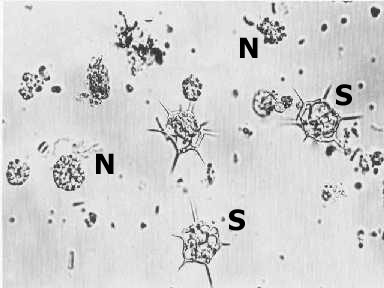Human activity can alter marine environements or affect marine organisms
What Where Effect
- Harvesting fish World-wide Changed size structure and species composition of fish
- Fishing methods World-wide Trawling destroys benthos; Dynamite fishing destroys reefs, kills unwanted animals
- Discard of by-catch World-wide Increased nutrient supply to benthos, oxygen problems
- Dam construction Rivers, estuaries Loss of anadromous fish
- Urban development Coast, estuaries, mangroves, coral reefs Loss of natural habitat; eutrophication/algal blooms; metal/other pollution
- Commercial shipping World-wide Introduction of alien species
- Coral mining Tropical reefs Destruction of reefs
- Greatest and most severe human impact: annually catch >100 million tons of fish and shellfish, constantly increasing due to technical development that makes finding fish easier (fish finder, echosounder, satellite navigation, etc.)
- Almost all fishgrounds (70%, FAO) are overfished: the catch-per-unit-effort decreases but with less fish their value increases, keeping fisheries lucrative;
- Changes in fish size and species composition: smaller, non-commercial species replace commercial species; commercial fish become smaller (40% decrease in size of Atlantic swordfish between 1978 and 1989)
- By-catch: non-commercial animals with no use, dumped back into the sea; most severe in shrimp fisheries: 4.2 kg fish for each kg of shrimp (GoM); can cause changes in benthic communities and oxygen problems (degradation)
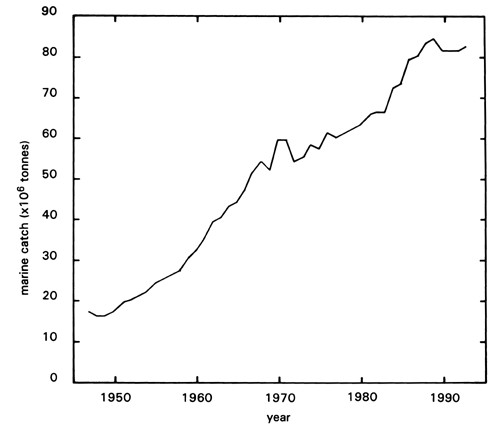
Increase in worldwide fisheries catch from 1949 to 1993
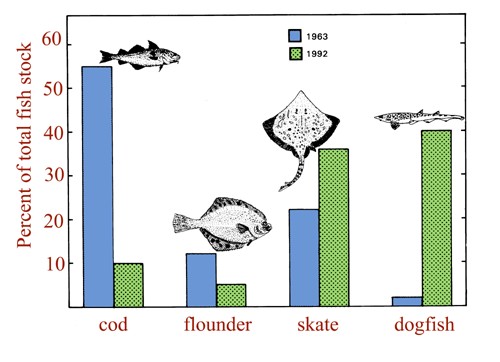
Change of fish composition on Georges Bank, Maine, between 1963 and the breakdown of the commercial cod fisheries in 1992
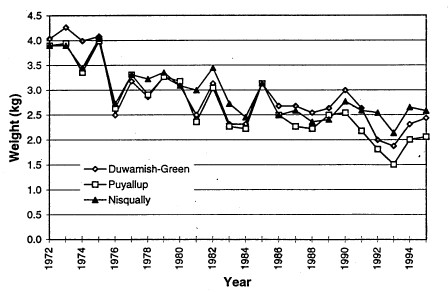
Decrease of average weight of coho salmon in three estuaries in Puget Sound, Washington State, USA.
Marine Pollutants
What where effect
- Petroleum, oil, hydrocarbons Local oil spills, Mass mortality benthos,birds; world-wide Low-level effects (unknown)
- Plastics Beaches Floating debris, Entanglement of animals, Ingestion by animals
- Pesticides Local-point sources Acute toxicity; World-wide Long-term toxicity/harm
- Heavy metals Industrial sources Mostly sublethal effects, reduced fertility, growth abnormalities
- Sewage Local-point source, agricultural runoff, rivers Eutrophication and altered community structure, Oxygen consumption, hypoxia, Introduction of pathogens
- Radioactive waste Power plants, dumping Considered below harmful levels
- Thermal effluents Power plants Altered community structure
- Sources: tanker accidents, conventional shipping and tank cleaning at sea, waste disposal, runoff, oil exploration, natural sources (cold seeps, Golf of Mexico)
- Tanker accidents are the most known oil spills because of vicinity to the coast and media coverage; however, they only contribute a small percentage
- Recovery time after an oil spill is ca. 5-10 years, dependent on temperature and wave action; 80% of hydrocarbons are degraded bacterially or evaporated after 2 months in open sea spills, leaving heavy hydrocarbons (long chains) behind
- World-wide average contamination in the ppb (parts per billion) range is considered harmless because toxic effects occur in the ppm (parts per million) range; long-term exposure effects are unknown, though
- Size can range from nylon drift nets to millimeter-sized plastic pellets
- Not biodegradable, plastic remains in the oceans for many years
- Birds and turtles mistake plastic for jellyfish and ingest them; 80% of shear-waters in a North Pacific survey had plastics in their stomachs
- Fish and mammals entangle in „ghost nets“ and drifting plastic and suffocate
- Chlorinated hydrocarbons: accummulate in tissue and are enriched along the food chain; reduced fertility, abnormals growth, thin egg-shell in birds. DDT, DDE (both now banned in USA and Europe): even measured in Antarctic penguins; Dioxin and PCB: highly toxic, banned in USA and Europe. TBT = tributyl tin: antifouling paints for ships, leaks into water;
- Heavy metals: mercury, copper, cadmium, lead; accummulate in food web, cell toxins, acute and chronic effects; „safe“ level depends on consumption of contaminated seafood;
- Sewage disposal is the major form of coastal pollution
- Release of organic matter, heavy metals, pesticides, detergents, oil, nutrients
- Nutrients can cause algal blooms, among the harmful/toxic blooms, alter the phytoplankton species composition (food chain effects!); can also promote growth of benthic green algae and cyanobacteria, which overgrow and destroy natural benthis communities
- Pathogenic bacteria and viruses can be introduced by sewage (e.g. Cholera epidemics in India by bathing in the polluted Ganges River)
- Oxygen consumption increases by bacterial degradation of organic matter and sedimented phytoplankton, causing hypoxia (anoxic conditions) and fish kills
- Agricultural runoff presents another major source of nutrient input into coastal seas, leading to eutrophication effects
- Aerial deposition of ammonia from cattle or pig farms contributes to coastal eutrophication
- Kiel Bight, Western Baltic Sea: Since 1983, annual, dense phytoplankton blooms discolored the water brown in May, which normally happened to be the „clearwater phase“ with seasonally lowest phytoplankton stocks
- Nutrient balance of nitrate:silicate was altered by eutrophication: in the 1930‘s, the phytoplankton spring bloom was ceased by nitrate exhaustion; in the 1980‘s, the spring bloom was ceased by silicate exhaustion, leaving plenty of nitrate behind for non-diatom phytoplankton to grow
- The phototrophic silicoflagellate Dictyocha speculum adapted to the new conditions in growing without its typical silica sceleton and formed dense, brownish blooms – altered nutrient conditions fostered a new growth form
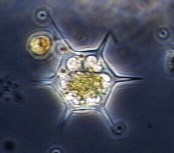 Dictyocha with
skeleton
Dictyocha with
skeleton